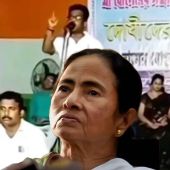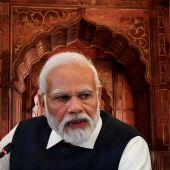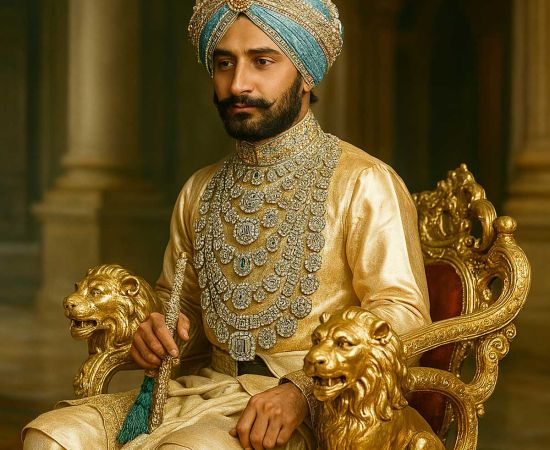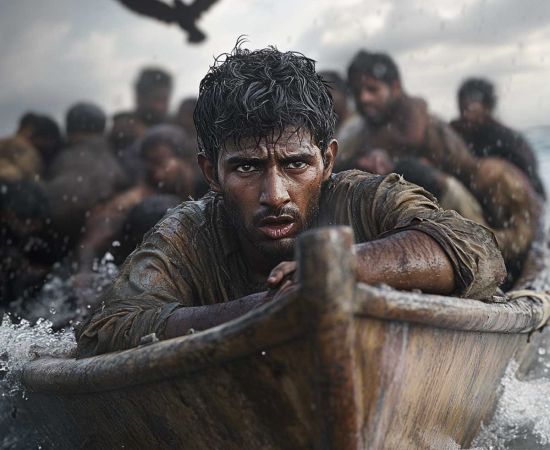Rani Chennamma of Keladi who fought bravely against Mughals and gave shelter to Shivaji’s son Rajaram, killed more than half of the forces of Aurangzeb's son Azamath Ara

She was a Lingayat, a devotee of Mahadev. She belonged to a merchant family from Kundapur, Karnataka. She was beautiful, pious, and virtuous. With a pearl-like complexion, broad forehead, curly hair, and bright eyes, an aura of divinity emanated from her. She was Chennamma.
She was married to Somashekara Nayaka, king of Keladi, Karnataka in 1667 CE. After the king died in 1677, Chennamma took the reins of the kingdom into her hands. She ruled efficiently for 26 years. During her rule, she fought several battles to victory. She fought bravely against Mughal Emperor Aurangzeb’s forces. It was the enemy Mughal forces who withdrew, sensing defeat, and begged for a treaty. It was for the first time that the Mughals proposed a peace accord with an Indian ruler! She also defeated the Sultan of Bijapur and the ruler of Mysore.
Chennamma’s Marriage
Somashekhara Nayaka became the king of Keladi in 1664. The Keladi kingdom during his reign stretched along the entire seacoast from Goa to Malabar. He was known far and wide for his handsome features, his efficient ruling, virtue, religious mindedness, power, and wealth. Many a king from near and far kingdoms wished to make him a son-in-law. Somashekhara Nayaka turned down every marriage proposal that he received.
The king once went to the Rameshwara fair. His eyes fell on Chennamma, the daughter of Siddappa Shetty, who happened to visit the Rameshwara temple along with her friends. It was love at first sight for the king. He decided that if at all he married, he would marry her.
Somashekhara Nayaka sent his Chief Minister to the abode of Siddappa Shetty with a marriage proposal. The latter advised him that she wasn’t from the royal blood, that the kings of Keladi married only royal princesses. But the king did not pay heed to his advice. Siddappa Shetty was bound to accept the king’s marriage proposal. The wedding took place at the king’s palace located in the capital city of Bidanur. It was the year 1667.
Chennamma’s Role in the Affairs of Keladi
Chennamma started learning the art of warfare after she became the queen of Keladi. In no time she became an expert in the use of weapons. Raja Somashekhara Nayaka gave her complete support. Soon she became well versed in politics and statecraft. She also started learning music and literature and mastered both subjects. She established a colony and facilitated the settlement of scholars from near and far-off states to spread knowledge of ancient wisdom in her kingdom.
The king sought the wise and witty Chennamma’s advice in administrative affairs and the judiciary. Her advice never went wrong. The people of Keladi started banking upon the queen. She helped the king punish the wicked and protect the virtuous and aided in an efficient ruling of the kingdom.
 |
Chennamma as Ruler of Keladi
Chennamma became a widow after 10 years of her marriage, i.e. in 1677. The ailing king was murdered by Bharame Mavuta, the foster father of the royal court dancer named Kalavathi. An expert in black magic, Bharame Mavuta, and Kalavathi had made the king their puppet. The king thereby failed in his duty of kingship.
Due to the king’s deteriorating health and childlessness, many nobles had by then already begun to hatch conspiracies to usurp the throne. But Chennamma managed the affairs of Keladi with an iron hand. She appointed only trusted people as ministers. She adopted Basappa Nayaka as her son and started training him in the art of warfare and the affairs of the kingdom.
Battle against Sultan of Bijapur
Bharame Mavuta conspired with the Sultan of Bijapur. News of a huge army of the Sultan approaching towards Bidanur reached the queen’s ears. Two robust forts, one in Bidanur and another in the thick jungles of Bhuvanagiri were Keladi’s strengths. As the queen wasn’t prepared for a fight against a huge force at that moment, she followed her ministers’ advice of transporting the throne of the kingdom, a wealth of the royal treasury, and all other valuables to Bhuvanagiri fort. When the enemy forces entered the Bidanur fort, they found it empty with no treasury or people.
At Bhuvanagiri, Rani Chennamma assembled her forces. Meanwhile, a few of Keladi’s commanders and ministers who did not support her at the beginning and had left her earlier arrived in Bhuvanagiri to take part in the battle against the enemy forces. Meanwhile, the Sultan’s forces marched towards Bhuvanagiri. A battle ensued between the two forces in the midst of a thick forest and a narrow pass. The Sultan’s army was badly defeated.
Battle against the Ruler of Mysore
When Chennamma became the ruler of Keladi, Chikkadevaraya Wodeyar was the ruler of Mysore. He declared war against Keladi, as he was driven by the notion that he could easily defeat a woman ruler. The chieftains of Sode, Sirsi, and Banavasi also declared war on Keladi. But the Queen defeated them all.
Three wars in total took place between Keladi and Mysore. Chennamma emerged victorious in the first and last. She treated the prisoners of war with honor and respect and set them free. Due to this act of the queen, Chikkadevaraya Wodeyar started respecting her. This was followed by a treaty of friendship between the two kingdoms.
Shelter to Son of Shivaji
Rajaram Raje Bhonsle, the younger son of Maratha ruler Chhatrapati Shivaji, was crowned at Raigad as the Maratha chief after the death of his half-brother Sambhaji. It was 12 March 1689. On 25 March 1689, the Mughals started laying siege to the region around Raigad. The Marathas fought against the Mughals and managed to let Rajaram escape through Kavlya ghat to Tamil Nadu. He was to seek refuge in the fort of Jinji.
Jinji Fort, located in Villupuram, Tamil Nadu, was built by the Cholas in the 12th century and was later enhanced by the Vijaynagara kings. It was built at a strategic place to fend off any invading armies. The fort came under the control of the Bijapur Sultanate in 1649. Chhatrapati Shivaji Maharaj defeated the Bijapuri forces in 1677 and captured the fort. The Maratha king ranked Jinji Fort as the most impregnable fortress in India. Such was its fortification! The Marathas chose this fort as a hideout for their chief Rajaram till the Mughals calmed down.
Rajaram reached the fort of Keladi in disguise. He sought refuge from Rani Chennamma and asked her for help for his safe passage and escape to Jinji Fort. The queen knew that if she gave shelter to Rajaram, the robust Mughals would certainly attack her kingdom. Yet she wasn’t bothered. She agreed. She welcomed Rajaram with the warmest of hospitality.
Battle against Aurangzeb’s Forces
Aurangzeb sent a messenger with a letter along with diamonds and precious stones to the Keladi court asking Rani Chennamma to hand over Rajaram to him. By the time the messenger reached her court, the queen had already facilitated Rajaram’s safe escape to Jinji Fort. The queen replied that handing over Rajaram was impossible. Aurangzeb had already sent his son Azamath Ara with a huge army to invade Keladi, as he expected that the queen would not give in to his request.
Queen Chennamma was fully prepared for the war. The brave Keladi soldiers led by the queen waylaid the huge Mughal army in Keladi through a thick jungle amid the downpour. They started butchering the Mughal soldiers following Guerrilla warfare techniques. Azamath Ara had defeated many kings, but now the very thought of getting defeated in the hands of a woman troubled him, as defeat was for sure.
Keladi forces captured a large number of horses and considerable war material from the Mughals. More than half of the Mughal forces were killed. It continued for a few days with the queen at the winning end. The Mughal army had been dwindling fast.
Meanwhile, Azamath Ara received a letter from Aurangzeb to leave Keladi and proceed towards Jinji Fort to attack Rajaram. An elated Azamath Ara begged for a peace treaty. The generous Rani Chennamma instead of crushing the rest of the forces or taking Azamath Ara prisoner, agreed to peace. Indian rulers had always followed the rules of Dharma in warfare. This was the reason why foreigners could stamp their identity and rule on Indian soil. Had Aurangzeb’s letter not reached Azamath Ara and had the Mughal prince not begged for peace, the defeat of the Mughals was for certain!
Rani Chennamma built the Mirjan fort. She ruled Keladi until she died in 1696.
Salute to Rani Chennamma! India will remember her valor and courage for eternity.
REFERENCES:
Saffron Swords: Centuries of Indic Resistance to Invaders - Manoshi Sinha Rawal, Yogaditya Singh Rawal
 Support Us
Support Us
Satyagraha was born from the heart of our land, with an undying aim to unveil the true essence of Bharat. It seeks to illuminate the hidden tales of our valiant freedom fighters and the rich chronicles that haven't yet sung their complete melody in the mainstream.
While platforms like NDTV and 'The Wire' effortlessly garner funds under the banner of safeguarding democracy, we at Satyagraha walk a different path. Our strength and resonance come from you. In this journey to weave a stronger Bharat, every little contribution amplifies our voice. Let's come together, contribute as you can, and champion the true spirit of our nation.
 |  |  |
| ICICI Bank of Satyaagrah | Razorpay Bank of Satyaagrah | PayPal Bank of Satyaagrah - For International Payments |
If all above doesn't work, then try the LINK below:
Please share the article on other platforms
DISCLAIMER: The author is solely responsible for the views expressed in this article. The author carries the responsibility for citing and/or licensing of images utilized within the text. The website also frequently uses non-commercial images for representational purposes only in line with the article. We are not responsible for the authenticity of such images. If some images have a copyright issue, we request the person/entity to contact us at satyaagrahindia@gmail.com and we will take the necessary actions to resolve the issue.
Related Articles
- Saraswathi Rajamani, at 16, became the youngest and first female spy for INA, boldly recruited by Netaji in 1942, courageously spent two years spying on the British in Myanmar during WWII, a pivotal yet overlooked heroine in India's struggle for freedom
- Godse's speech and analysis of fanaticism of Gandhi: Hindus should never be angry against Muslims
- Our first true war of independence lie forgotten within the fog of time and tomes of propaganda: Sanyasi Rebellion, when "renouncers of the material world" lead peasants in revolt against British and fundamentalist islamic clans
- "Behold it is born. It is already sanctioned by the blood of martyred Indian youths": Madam Bhikhaiji Cama, the Brave lady to first hoist India’s flag on foreign Soil - Formative Years
- Khudiram Bose - The symbol of valiance and death-defying youth, an orphan at 7 to hanging by the British at 18
- "A horse gallops with his lungs, perseveres with his heart, and wins with his character”: Shubhrak seeing his master in danger became uncontrollable and threw Qutubuddin on the ground, stomped his chest and head with mighty hooves killing him on the spot
- Debunking the myth of "De Di humein Aazadi Bina Khadag Bina Dhal": Bharat’s founding story bestows upon it an extravagant national philosophy and long-lasting costs
- Santi Ghosh and Suniti Choudhury: Two Teenage Freedom Fighters Assassinated British Magistrate
- Film based on Nathuram Godse ‘Why I killed Gandhi’ gets opposition from Congress party demanding to ban the movie in Maharashtra, Cine Workers Association seek nationwide ban
- In a historical move ahead of Republic Day on January 26th, the Amar Jawan Jyoti flame at the India Gate would be merged with the flame at the National War Memorial on Friday
- A troubled childhood - Rajguru: The Invincible Revolutionary
- "The nation which forgets its defenders will be itself forgotten": Asilatha Godse, also known as Himani Savarkar was the daughter of Gopal Godse and niece of Nathuram Godse who preserved every book of Savarkar when the Congress was destroying his work
- A revolutionist freedom fighter who the British Raj framed for murder
- The Eki Movement of hero Motilal Tejawat whose last wish is still waiting to be fulfilled - 100 years of Palchitaria massacre in Gujarat and its cover-up by the British govt
- Hero of Pawankhind: Veer Maratha Bajiprabhu Deshpande, who led 300 Soldiers against 12000 Adilshahi Army defending Shivaji













